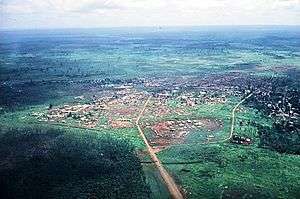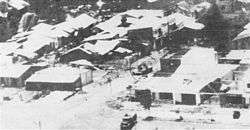Battle of An Lộc
| Battle of An Lộc | |||||||
|---|---|---|---|---|---|---|---|
| Part of the Vietnam War | |||||||
 An Lộc, as viewed from the air in 1972. | |||||||
| |||||||
| Belligerents | |||||||
|
|
| ||||||
| Commanders and leaders | |||||||
| Trần Văn Trà |
Lê Văn Hưng Lê Nguyên Vỹ | ||||||
| Strength | |||||||
5th NLF Division ~ 9,230 |
3rd Ranger Group: 1,300 Reinforcements: 25,000+ | ||||||
| Casualties and losses | |||||||
|
U.S. estimate: 10,000 casualties[1] |
ARVN reported: 2,280 killed 10 aircraft, 20 helicopters lost[3]:188 | ||||||
The Battle of An Lộc was a major battle of the Vietnam War that lasted for 66 days and culminated in a decisive victory for South Vietnam. In many ways, the struggle for An Lộc in 1972 was an important battle of the war, as South Vietnamese forces halted the North Vietnamese advance towards Saigon.
Prelude
An Lộc is the capital of Bình Phước Province located northwest of Military Region III. During North Vietnam's "Easter Offensive", (known in Vietnam as the Nguyen Hue Offensive) of 1972, An Lộc was at the centre of People's Army of Vietnam (PAVN) strategy, its location on QL-13 near Base Area 708 in Cambodia allowed safeguarding supplies based out of a "neutral" location in order to reduce exposure to U.S. bombing. To protect this critical area, the Army of the Republic of Vietnam (ARVN) had essentially a single division in Bình Phước Province, the 5th Division.[4] During the battle, the 5th Division was outnumbered by a combined force consisting of three PAVN and Viet Cong divisions. This fighting which ensued became the most protracted conflict of the 1972 Easter Offensive.
On the same day that Lộc Ninh, a small town 20 miles (32 km) north of An Lộc on the border with Cambodia was assaulted, the PAVN 7th Division launched an attack on QL-13 in an attempt to cut off An Lộc from Saigon. To control route QL-13 was to control the road to Saigon, roughly 90 miles (140 km) to the south. This prevented resupply of ARVN forces in An Lộc.
Battle
On the evening of April 7, elements of the PAVN 9th Division overran Quần Lợi Base Camp. Its defenders, the 7th Regiment of the 5th Division, were ordered to destroy their heavy equipment (including a combined 105mm and 155mm artillery battery) and fall back to An Lộc.[4]:70 Once captured, the PAVN used Quần Lợi as a staging base for units coming in from Cambodia to join the siege of An Lộc.[4]:91 Key members of COSVN were based there to oversee the battle.[4]:119
On April 8, the small town of Lộc Ninh was overrun and about half of the defenders escaped to An Lộc.[4]:56–57
The ARVN defenders of An Lộc were made up of several units of the 5th Division, including the Division's 8th Regiment with about 2,100 men; the 7th Regiment which was short one battalion and only had 850 men; the 9th Regiment, most of which was destroyed at Lộc Ninh had only had 200 men; Task Force 52, 500 men; the 3rd Ranger Group, 1,300 men; as well as Binh Long Provincial Regional Force, Popular Forces, and People's Self-Defense Forces (PSDF), about 2,000 men.[4]:80 The defenders were later reinforced by the elite 81st Airborne Commando Battalion and the 1st Airborne Brigade, brought in by air because QL-13 was blocked by the PAVN.[5] Because the ARVN defense had little artillery, it was heavily reliant on U.S. air support. Other reinforcements consisted of the 21st Division which was plagued by a very slow move from the Delta area in the south of the country and cleared QL-13 after protracted fighting.
The ARVN defenders did have one card to play throughout the battle, the immense power of U.S. air support. The use of B-52 Stratofortress bombers (capable of carrying 108 MK82 (500 pound) bombs on one run) in a close support tactical role, as well as AC-119 Stinger and AC-130E Spectre gunships, fixed wing cargo aircraft of varying sizes, AH-1 Cobra attack helicopters and Vietnamese Air Force (VNAF) A-37s. These methods worked to blunt the PAVN offensive. At this stage in the war, the PAVN often attacked with PT-76 amphibious and T-54 medium tanks spearheading the advance, usually preceded by a massive artillery barrage. These tactics reflected Soviet doctrine, as the PAVN had been supplied with Soviet and Chinese Communist equipment, including jets, artillery, and surface to air missiles since the beginning of the war. The battle eventually stagnated and became a periodic trade of artillery barrages. This was most probably a result of casualties sustained in the frustrated attacks on heavily entrenched enemy positions in control of a withering array of supporting firepower.
The first attack on the city occurred on April 13 and was preceded by a powerful artillery barrage. The PAVN captured several hills to the north and penetrated the northern portion of the city held by the 8th Regiment and 3rd Ranger Group.[4]:88–97 ARVN soldiers were not accustomed to dealing with tanks, but early success with the M72 LAW, including efforts by teenaged members of the PSDF went a long way to helping the overall effort.[4]:90 The 5th Division commander, General Hung, later ordered tank-destroying teams be formed by each battalion, which included PSDF members who knew the local terrain and could help identify strategic locations to ambush tanks.[4]:98 They took advantage of the fact that the PAVN forces, who were not used to working with tanks, often let the tanks get separated from their infantry by driving through ARVN defensive positions. At that point, all alone inside ARVN lines, they were vulnerable to being singled out by tank-destroying teams.

April 15 saw the second attack on the city. The PAVN were concerned that because the ARVN 1st Airborne Brigade had air-assaulted into positions west of the city, that they were now coming to reinforce the defenders. Again the PAVN preceded their attack with an artillery barrage followed by a tank-infantry attack. Like before, their tanks became separated from their infantry and fell prey to ARVN anti-tank weapons.[4]:101 PAVN infantry followed behind the tank deployment, assaulted the ARVN defensive positions, and pushed farther into the city. B-52 strikes helped break up some PAVN units assembling for the attack. This engagement lasted until tapering off on the afternoon of April 16.[4]:103
Unable to take the city, the PAVN kept it under constant artillery fire. They also moved in more anti-aircraft guns to prevent aerial resupply. Heavy anti-aircraft fire kept VNAF helicopters from getting into the city after April 12.[4]:113 In response, fixed wing VNAF aircraft (C-123's and C-119's) made attempts, but after suffering loses, the U.S. Air Force took over on April 19.[4]:113 The US used C-130's to parachute in supplies, but many missed the defenders and several aircraft were shot down or damaged. Low altitude drops during day and night did not do the job, so by May 2, the USAF began using High Altitude Low Opening (HALO) techniques. With far greater success, this method of resupply was utilized until June 25, when the siege was lifted and aircraft could land at An Lộc.[4]:115 Over the entire course of the resupply effort, the garrison recovered several thousand tons of supplies—the only supplies it received during the siege.
On May 11, 1972, the PAVN launched a massive all-out infantry and armor (T-54 medium tanks) assault on An Lộc. The attack was carried out by units of the 5th and 9th PAVN divisions.[4]:145 This attack was repulsed by a combination of U.S. airpower and the determined stand of ARVN soldiers on the ground. Almost every B-52 in Southeast Asia was called in to strike the massing enemy tanks and infantry. The commander of the defending forces had placed a grid around the town creating many "boxes", each measuring 1 km by 3 km in size, which were given a number and could be called by ground forces at any time. The B-52 cells (groups of 3 aircraft) were guided onto these boxes by ground-based radar. During May 11 and 12, the U.S. Air Force managed an "Arc Light" mission every 55 minutes for 30 hours straight—using 170 B-52's and smashing whole regiments of PAVN in the process. Despite this air support, the PAVN made gains, and were within a few hundred meters of the ARVN 5th Division command post.[4]:150 ARVN counter-attacks were able to stabilize the situation. By the night of May 11, the PAVN consolidated their gains.[4]:152 On May 12, they launched new attacks in an effort to take the city, but again failed.[4]:153 The PAVN launched one more attack on May 19 in honor of Ho Chi Minh's birthday. The defenders were not surprised, and the attack was broken up by U.S. air support and an ambush by the ARVN paratroopers.[4]:157
After the attacks of May 11 and 12, the PAVN directed its main efforts to cutting off any more relief columns. However, by the 9th of June this proved ineffective, and the defenders were able to receive the injection of manpower and supplies needed to sweep the surrounding area of PAVN. By June 18, 1972, the battle had been declared over.
Aftermath
The victory, however, was not complete, QL-13 still was not open. The ARVN 18th Division was moved in to replace the exhausted 5th Division. The 18th Division would spread out from An Lộc and push the PAVN back, increasing stability in the area.
On August 8, the 18th Division launched an assault to retake Quần Lợi, but were stopped by the PAVN in the base's reinforced concrete bunkers. A second attack was launched on August 9 with limited gains. Attacks on the base continued for 2 weeks; eventually one third of the base was captured.[4]:198 Finally, the ARVN attacked the PAVN-occupied bunkers with TOW missiles and M-202 rockets, breaking the PAVN defense and forcing the remaining defenders to flee the base.[4]:201
The fighting at An Lộc demonstrated the continued ARVN dependence on U.S. air power and U.S. advisors. For the PAVN, it demonstrated their logistical constraints; following each attack, resupply times caused lengthy delays in their ability to properly defend their position.[4]:213–214
References
- ↑ Tucker, p. 51.
- ↑ Hồ sơ cục Quân y: Chiến dịch Nguyễn Huệ 4/1972 - 1/1973: 13.412 wounded (26,83% total forces); included fase 1 (battle of Loc Ninh and battle of An Loc): 6,214 wounded. Total killed or missing during the campaign: 3,961 (included 50% in fase 1)
- 1 2 Thi, Lam Quang (2009). Hell in An Loc: The 1972 Easter Invasion and the Battle that Saved South Vietnam. University of North Texas Press. p. 187. ISBN 9781574412765.
- 1 2 3 4 5 6 7 8 9 10 11 12 13 14 15 16 17 18 19 20 21 22 Lam, p. 35–6.
- ↑ McDermott, p. 51-54.
Further reading
- McDermott, Mike (2012). True Faith and Allegiance, An American Paratrooper and the 1972 Battle for An Loc. The University of Alabama Press. ISBN 9780817317553.
- Willbanks, James H. (2005). The Battle of An Loc. Indiana University Press. ISBN 0253344816. OCLC 55990164.
- Tucker, Spencer C. (2011). The Encyclopedia of the Vietnam War: A Political, Social, and Military History (2nd ed.). Santa Barbara, California: ABC-CLIO. ISBN 9781851099603.
External links
- BATTLE OF AN LOC (VALIANT BINH LONG)
- Battle of An Loc - by Lieutenant Colonel James H. Willbanks
- The Battle of An Loc - A Massive Convergence of Forces